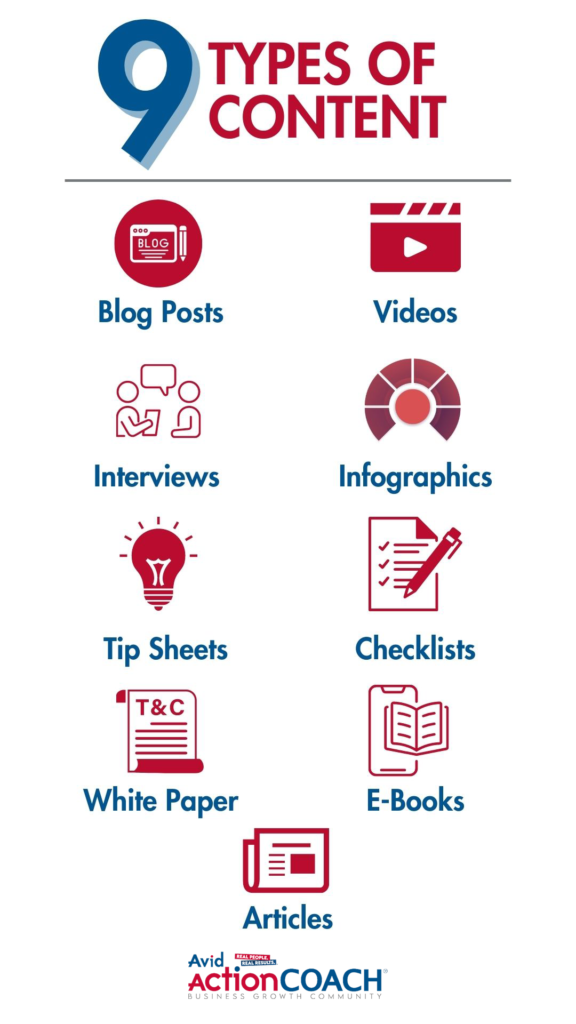In today’s competitive digital landscape, content is king. Businesses that want to thrive must master the art of creating and sharing the right kind of content. But with so many options available, how do you know which content types will best serve your business and engage your audience?
A well-rounded content strategy isn’t just about quantity—it’s about tapping into content formats that resonate most with your audience, meet their needs, and drive them to take action.
In this post, we’ll break down the 9 types of content every business should use to grow its audience and how each format plays a crucial role in your overall marketing strategy.

1. Blog Posts
Blog posts are one of the most versatile and powerful content types you can create. They’re ideal for educating your audience, improving SEO, and establishing your brand as an authority in your industry. Consistent blog posting helps your business rank higher on search engines, attracts organic traffic, and provides a platform for sharing insights and expertise.
Why It’s Effective:
Blog posts can cover a wide range of topics, from how-tos to thought leadership pieces. They are a key part of inbound marketing, helping businesses attract leads by offering valuable, informative content that answers customer questions.
2. Videos
Video content is exploding in popularity. From tutorials to testimonials and behind-the-scenes footage, videos allow you to connect with your audience on a personal level. Video marketing is particularly effective because it engages viewers visually and emotionally, making it one of the most impactful forms of content.
Why It’s Effective:
Consumers are more likely to remember and share video content compared to other types. It’s also a great way to demonstrate products, explain services, or share customer success stories in a format that is easy to digest.
3. Interviews
Interviews with industry experts, customers, or team members provide valuable insights and diverse perspectives. They offer authenticity and credibility, which is invaluable for building trust with your audience. Sharing interviews can position your business as a thought leader and showcase your network and expertise.
Why It’s Effective:
Interviews give you the opportunity to showcase real-world experiences and expertise, which builds authority and adds a human touch to your content. They’re also highly shareable and can generate significant engagement.
4. Infographics
Visual learners will appreciate infographics—graphics that present complex information in a simple, engaging way. Infographics are excellent for simplifying data, statistics, and processes that would otherwise be difficult to explain in text form. They’re highly shareable, making them ideal for social media marketing.
Why It’s Effective:
Infographics can break down complex ideas into digestible, visually appealing formats. This makes it easier for your audience to understand and remember key takeaways. They’re also great for enhancing blog posts and white papers.
5. Tip Sheets
Tip sheets are short, actionable guides that offer your audience quick advice or practical steps to solve a specific problem. They are often used as lead magnets—valuable content pieces that you offer in exchange for a customer’s contact information.
Why It’s Effective:
Tip sheets provide immediate value, helping your audience solve small problems quickly. They’re a great way to demonstrate your expertise and build trust with potential customers.
6. Checklists
Checklists are another highly actionable type of content that guides your audience through a specific process. Whether it’s a checklist for starting a business, launching a product, or improving productivity, these are incredibly useful tools that people can refer back to time and again.
Why It’s Effective:
Checklists simplify tasks and help your audience stay organized. They’re often seen as “bookmark-worthy” content, which increases the likelihood that users will return to your site.
7. White Papers
White papers are in-depth reports that provide detailed information or expert analysis on a specific topic. They’re often used in B2B marketing to educate and inform an audience about complex issues. White papers are ideal for businesses that want to position themselves as industry experts and thought leaders.
Why It’s Effective:
White papers are seen as authoritative, making them a great way to build trust and demonstrate expertise in your industry. They can also generate high-quality leads when used as gated content.
8. E-Books
E-books provide more depth than a blog post or article, allowing businesses to dive into a topic in great detail. They are an excellent way to establish credibility and demonstrate thought leadership. Like white papers, e-books can be used as gated content to generate leads.
Why It’s Effective:
E-books are great for educating your audience in a more comprehensive way. They’re often seen as premium content, making them a valuable tool for attracting leads who are serious about solving the problem your business addresses.
9. Articles
Articles are often published on third-party platforms, like industry publications or guest blogs. They help you reach new audiences, build backlinks for SEO, and position your business as an industry leader. Publishing articles on well-known platforms can elevate your credibility and expand your brand’s reach.
Why It’s Effective:
By contributing valuable insights to reputable platforms, you build brand awareness and enhance your authority. Articles also contribute to your SEO efforts by generating backlinks to your site.
Conclusion
Mastering the various types of content available to you is essential for growing your business in the digital age. From blog posts and videos to e-books and infographics, each format has a unique role to play in your content strategy. By leveraging these 9 types of content, you can create a well-rounded marketing strategy that engages your audience, drives traffic, and boosts conversions.
Diversifying your content isn’t just about keeping things fresh—it’s about strategically reaching your audience where they are and offering value in different ways. By doing so, you position your business as an industry leader, ready to provide solutions and insights that matter most to your customers.

